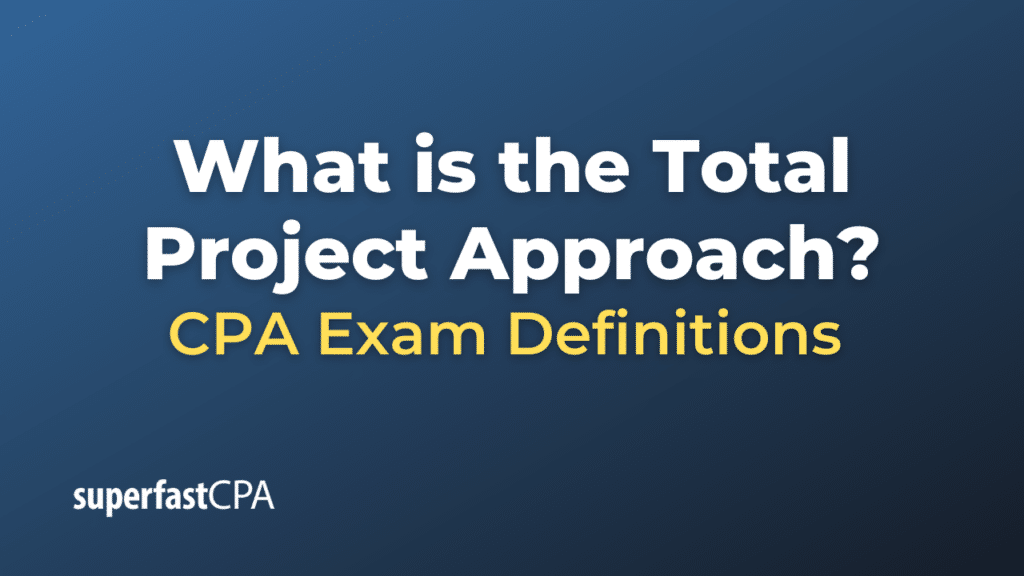Total Project Approach
The “Total Project Approach” refers to a comprehensive and integrated method for planning, executing, and managing projects. Instead of viewing individual tasks or components in isolation, this approach considers the project as a whole, ensuring that every element contributes to the overarching objectives and goals of the project.
Some key principles and characteristics of the Total Project Approach are:
- Holistic Perspective: The project is viewed as a unified entity rather than a collection of disjointed tasks. Every activity and decision is evaluated based on its impact on the overall project outcome.
- Integration: All project components, including scope, time, cost, quality, resources, risks, and stakeholder requirements, are intricately linked and managed cohesively.
- Stakeholder Involvement: This approach emphasizes the importance of identifying all project stakeholders early on and ensuring their needs and expectations are addressed throughout the project lifecycle.
- Dynamic Response: Recognizes that projects operate in dynamic environments. Hence, regular monitoring, feedback, and adaptability are crucial to respond to changes and unforeseen challenges.
- End-to-End Management: From the inception and planning stages through to the closing phase, every aspect of the project is managed with the total project outcomes in mind.
- Value Delivery : The focus is not just on completing the project but ensuring that the final deliverable brings the intended value to the organization and stakeholders.
- Risk Management : Proactively identifies potential risks and devises strategies to mitigate or respond to them, ensuring that the project stays on track even in the face of challenges.
Using the Total Project Approach ensures that the project manager and the team remain focused on delivering a successful project outcome, taking into account all elements and potential challenges. It’s particularly beneficial for complex projects where multiple components must be coordinated seamlessly.
Example of the Total Project Approach
Let’s delve into a hypothetical example to better understand the Total Project Approach.
Scenario: The city of “GreenVille” wants to develop a sustainable public park. This park aims not only to provide recreational space but also to improve air quality, support biodiversity, and offer educational opportunities about sustainability for residents.
Total Project Approach:
- Holistic Perspective: Rather than just focusing on planting trees or constructing walkways, the project committee considers how every element of the park interacts. They decide to integrate a rainwater harvesting system that can water plants and a solar-powered lighting system to illuminate pathways.
- Integration: The committee develops a comprehensive plan, factoring in the landscaping, infrastructure, maintenance, community engagement, and educational programs. Every decision, from the type of plants chosen to the design of information plaques, is made with the whole project in mind.
- Stakeholder Involvement: Before finalizing the design, the committee organizes community engagement sessions. Residents share their ideas, which include a community garden and an open-air classroom. These suggestions are integrated into the project plan.
- Dynamic Response: Midway through the project, a rare species of bird is discovered nesting in the area. The committee adapts the design to protect the habitat, adding bird-watching platforms and informational signs about the species.
- End-to-End Management: From initial design sketches to the park’s inauguration ceremony, every phase is managed cohesively. The committee ensures that the park’s development aligns with its sustainability and educational objectives throughout.
- Value Delivery: Once completed, the park doesn’t just offer recreation. It becomes a hub for community gardening, sustainability workshops, bird-watching, and school field trips. The diverse range of activities ensures the park brings significant value to GreenVille’s residents.
- Risk Management: During the development, potential risks like seasonal flooding, vandalism, and budget overruns are identified. Preventive measures, such as raised walkways, security cameras, and regular budget reviews, are put in place.
Outcome:
Thanks to the Total Project Approach, GreenVille’s public park becomes more than just an open space. It turns into a model of sustainable development, community involvement, and environmental education. The comprehensive approach ensures that every decision, from major design elements to small details, contributes to the project’s overall success and the community’s well-being.













